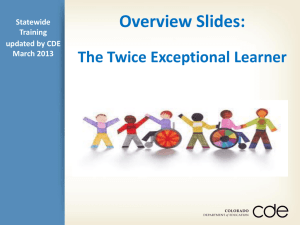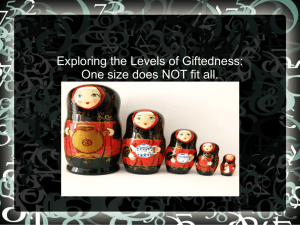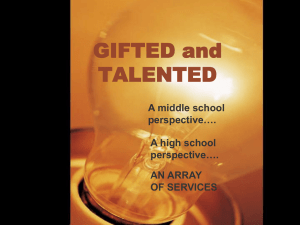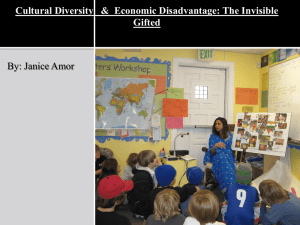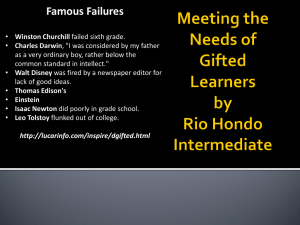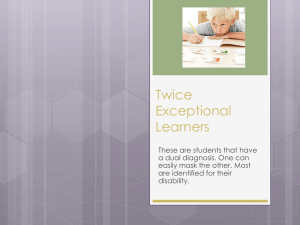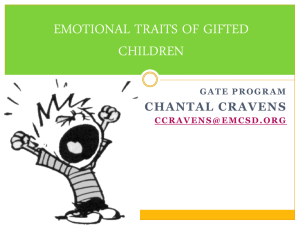Multi-Exceptional BG 2010 - Kentucky Association for Gifted
advertisement
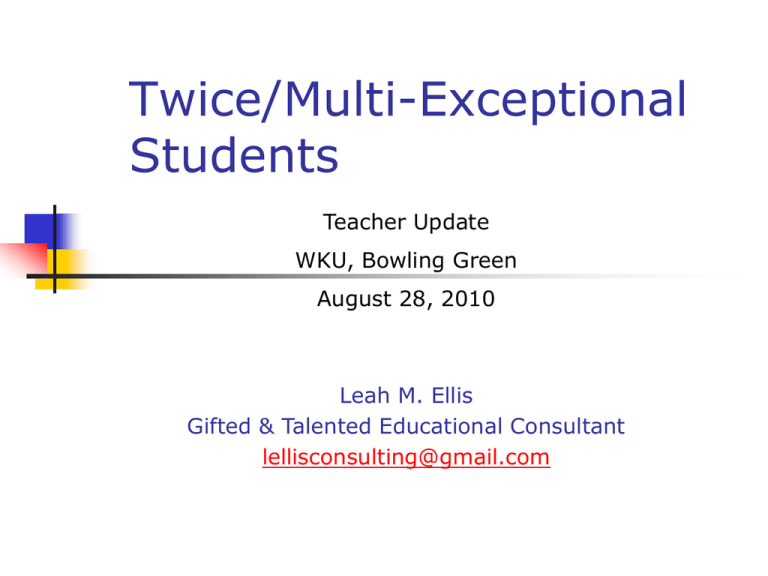
Twice/Multi-Exceptional Students Teacher Update WKU, Bowling Green August 28, 2010 Leah M. Ellis Gifted & Talented Educational Consultant lellisconsulting@gmail.com Overview What is a twice or multi-exceptional child? Challenges of the issue Identification & Characteristics Programming/Services Recommendations/Strategies Responsibilities/Attitudes What is a Twice or MultiExceptional student? Twice Exceptional students have gifts/talents with a specific disability. Multi-Exceptional students have gifts/talents and have more than one disability. More Specifically… The educational term "exceptional" can be applied to gifted children because of their above-average cognitive ability. When gifted children are also "exceptional" because of a learning disability (a disorder that adversely impacts their learning) they may be referred to as "twice exceptional" ("2E" or 2X"), or as gifted/learning disabled (gifted/LD), or simply "multi-exceptional" a term which acknowledges that a person may have more than one disability. Julie Shepherd Knapp, 2006 Who are the Twice or Multi-exceptional? The one common trait is that they possess giftedness as well as a deficit. The largest group of twice exceptional students are those who have a disability & are academically gifted. They are found within every socioeconomic, cultural, racial, & ethnic population. They are present in almost every classroom. They are students at risk of not achieving their potential. They are the most frequently under-identified population in our schools. A group of educationally vulnerable pupils whose profiles are often underrepresented in gifted/talented populations. The Big Challenges: Appropriate services are not provided Underserved students Difficulty in meeting the unique needs Not much research in the area of Multiexceptional Identification Challenges Inadequate procedures resulting in underrepresentation. Labeled first as “disabled”, remediation is the primary concern, not in GT ID. Few Special education teachers have been exposed to GT characteristics and may observe deviations from the norm as being unique to the disabling condition. (B. Clark) Some tests that diagnose hyperactivity, withdrawal or disruptive behavior are often tests that spot GT ability. Identification Considerations Identification is Complicated: the necessary knowledge of both giftedness & special education and the awareness of the relationship between the two areas of exceptionality. Hidden disabilities/abilities that complicate the assessment & identification process (ADHD, LD, AS). Procedures must consider assessments in both giftedness and disabilities. Actively seek GT students among the students with disabilities population Suggested ID Considerations Use culturally sensitive assessment processes to prevent cultural bias. Look for subtle indicators of exceptionality in students, remembering that ones abilities are often masked by disability and vice/versa. Look for discrepancies in performance including passing hard tasks and failing easy ones. Assess & compare oral vs. read materials, math analysis vs. computation, timed vs. untimed. Look for unusual abilities. Observe adaptations children make; note special strengths & difficulties ID Considerations cont. Use multiple data sources: Both Formal & Informal data: Tests of intellectual ability, achievement tests, creativity tests, student work/portfolio, recommendations Teacher Report of student Functioning: observations, recommendations Family History/Student Background: Conference with families about student performance outside of school, student interviews, parent surveys Nominations/Formal recommendations: Teachers, parents, peers, self, psychologists, community members Student Inventory to include interests, strengths, learning styles, values, etc. Awards & Achievements Behavioral Checklists of specific characteristics of GT students with disabilities 3 Main Categories (Baum, 1990) Formally identified GT, but not identified as having a disability (Giftedness masks the disability) - Goes unnoticed for possible special education. - May be considered an underachiever, lazy, or unmotivated. - Maintains grade-level expectations until difficulty increases (middle & high school). Formally identified disability, but not identified as GT (Disability masks giftedness) - May be in special education focused solely on remediation or compensation of the disability. - Significantly underestimated intellectual abilities due to inadequate assessment that yielded depressed IQ scores. - Bored in special programs if services do not match challenge level. - Often misdiagnosed as having an emotional disability. Categories continued: Not formally identified as either GT or having a disability (Components mask each other) - Achieving at grade level and assumed to have average ability. - Show signs of difficulty as curriculum becomes more challenging. - Perceived as performing within expectations and therefore never referred for special education evaluation. - Deflated achievement and test scores due to disability and not qualifying for gifted education services. Characteristics of Gifted Students with Disability Impaired long & short-term memory Visual or auditory processing difficulties Visual motor integration problems Poor self-concepts High levels of self-criticism, withdrawal, or aggressive behaviors Short attention spans Difficulty following directions Poor peer relations (Suter & Wolf 1987) Twice Exceptional Learner Profile Decent grades, grade-level district assessments, well above average IQ, reading decoding skills below average. Having a combination of some gifted abilities and areas that require intensive interventions Multi-Exceptional Learner Profile Well above grade level reading skills, creative thinker, gifted athlete & artist, grade level testing is slightly above average, A’s in classes she likes and F’s in classes (or with teachers) she dislikes, behavioral, emotional & social disabilities (BiPolar, anxiety, ADD, OCD). The unique combination of needs requires intensive interventions for both giftedness and exceptionalities. Because of her behavioral difficulties, she drops out of school. Underachieving GT & LD/GT Compared (Silverman 1989) Key Characteristics Lack of social skills Social isolation Unrealistic self-expectations Perfectionist tendencies Distractibility Frustration in response to school demands Low self-esteem Failure to complete assignments Gifted Regulation Support for ID & Services Section 3. Identification and Diagnosis of Gifted Characteristics, Behaviors, and Talent and Determination of Eligibility for Services. (3) A local school district shall provide a system for diagnostic screening and identification of strengths, gifted behaviors and talents which provides equal access for racial and ethnic minority children, disadvantaged children, and children with disabilities. Section 4. Procedure for Determining Eligibility for Services. (2) Exceptions and special considerations for eligibility. School personnel shall take into consideration environmental, cultural, and disabling conditions which may mask a child's true abilities that lead to exclusion of otherwise eligible students, such as a student who qualifies as: (a) An exceptional child as defined in KRS 157.200; (b) Disadvantaged; or (c) Underachieving. Addressing the Needs Students require a combination of gifted and special education services. Teach the whole child, not just a part of the child. The general classroom teacher has responsibilities to this population. Classroom Teacher Responsibilities When teaching twice-exceptional students in their area of strength, offer them the same compacting and differentiation opportunities available to other students. When teaching in the area of challenge, teach them directly whatever strategies they need to increase success. Never take time away from their strength to create more time on their deficiencies. Winebrenner, 2003 Effective Practices: Gather info to identify student needs and strengths. Develop and implement IEPs that have GT strategies and GSSPs that have special education strategies. Collaboration/ Expert Consultation. Meet individual needs (May need use of special ed or gifted services, after school activities, clubs, independent study, arts programs, etc.). In the Classroom: Simultaneous provision of gifted instruction & specialized instruction, adaptations & accommodations. Make students an active part of the class. Hold high expectations for these students as well. Key Issues to Consider in the Classroom : Accommodate Academic Strengths/Giftedness Accommodate Academic Weaknesses/Disabilities Provide Direct Instruction to Support Classroom success Address Social & Emotional Issues Address Behavioral Issues Accommodating Academic Strengths/Giftedness Focus on developing personal strengths. Focus on higher order thinking & reasoning skills to include student inquiry & questioning. Find students strongest Learning Style. Incorporate instruction with in-depth lessons & concept development in student interest & passion areas. Use an interdisciplinary curriculum to allow for connectedness between topics. Use alternate ways to demonstrate understanding (CRUCIAL). Where appropriate, provide compacting, differentiation, acceleration. Explore multiple avenues to meets needs: after school activities, clubs, related arts-programs, mentoring, online learning, independent studies. Do not use gifted services as an incentive for addressing behavioral problems or academic weaknesses. Allow students to participate in enrichment experiences. Accommodating Academic Weaknesses/Disabilities Hands-on Activities Graphic Organizers Differentiation (Adjust content, process & product/assessment) Direct instruction in skills that affect disability Allow Assistive Technology where appropriate Make modifications (keyboarding, spell check) Necessary accommodations: extended test/work time, quiet/less distracting environment, etc. Direct instruction in study skills & learning strategies Promote student self-determination by developing selfunderstanding, goal setting, self-advocacy Provide Direct Instruction to Support Classroom success May include Content &/or Direct Instruction in: - Writing - Organization - Reading - Mathematical Calculations - Test Taking Strategies Additional Comments This special population: may have extremes of ability existing in one student (disabilities & giftedness). may underestimate their own capabilities and choose not to pursue post-secondary education. when needs are met, has shown growth in closing achievement gaps. is more likely to drop out of school possibly adding to homelessness, low-income housing, criminal activity. represents unrealized potential such as inspiring leaders who are never elected, cures for diseases never discovered, revolutionary inventions never patented, thrilling novels that are never written, groundbreaking theories never conceived. Closing Comments Do you know of students not performing up to expectations? Do you think you might have a twice/multiexceptional student in your schools? Do you feel you have some tools for helping them achieve their potential? References/ Additional Resources The Twice-Exceptional Dilemma, National Education Association, www.nea.org Supporting Emotional Needs of the Gifted, www.sengifted.org National Association for Gifted Children, www.nagc.org Council for Exceptional Children www.cec.sped.org Hoagies Gifted / Twice Exceptional http://www.hoagiesgifted.org/twice_exceptional.htm Uniquely Gifted http://www.uniquelygifted.org/ 2E Newsletter http://2enewsletter.com/welcome%20page.htm Clark, Barbara. Growing Up Gifted. Merrill, Prentice Hall
